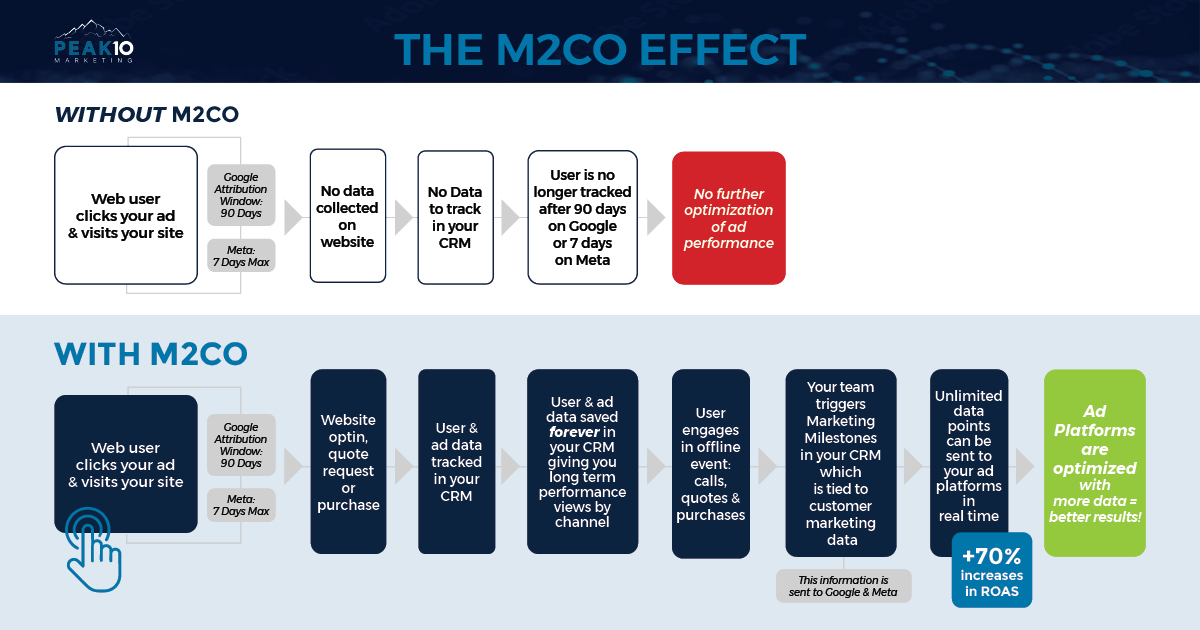Solving the Manufacturing Advertising Data Dilemma of Connecting Online Marketing with Offline Sales with M2CO

Remember when you could actually see what was working in your ad campaigns? When a click turned into a form fill, and a form fill turned into a sale, and the ad platform took a victory lap because it knew it was responsible?
That world’s gone.
These days, running digital ads can feel like trying to drive through a fog bank with your headlights off. Apple’s ATT policy and the shift to a cookieless web have made third-party tracking unreliable. The truth is, Google and Meta actually have more data than ever, but they are locking it inside their own walled gardens, leaving advertisers with fewer signals and less visibility into what is really converting.
And if you’re a small business or a manufacturer trying to run paid ads, that’s a big problem. Without accurate feedback, and enough conversion events (25/week for Google, 50/week for Meta – per AD SET), the algorithms can’t fully optimize. You end up overpaying for traffic that doesn’t convert, or worse, you miss the best opportunities entirely.
But here’s the good news: you don’t have to stay stuck in the fog.
Peak 10 Marketing’s M2CO Method: Rebuilding the Signal Path
At Peak 10, we built a system to bring clarity back to your campaigns.
It’s called the Marketing Milestone Conversion Optimization Method, or M2CO for short. And it’s designed to restore the feedback loop between your sales results and your ad platforms using first-party data you already own.
M2CO transforms your CRM into a teaching tool for your ad platforms, so Google and Meta learn from your actual sales, not just website activity. The result: campaigns that optimize for revenue, not just clicks.
This isn't another marketing tool, it's a process improvement applied to advertising. We're creating a closed-loop feedback system that eliminates waste and optimizes for actual output: revenue
M2CO doesn't just help optimize campaigns for conversion milestones and revenue, it also helps identify top audiences. This improves targeting and top performing ads, which improves ad creative and messaging. The effect is compounding optimization across the elements that matter most.
Here’s how it works:
We capture conversion data at every key milestone of your customer journey; leads, quotes, sales calls, purchases, and then push that data back into Google and Meta using their API integrations.
But M2CO isn’t just a data pipeline; it’s part of our Precision Marketing System that allows us to build smarter marketing that actually moves the needle.
Technical Deep-Dive: M2CO leverages Google's Offline Conversion Imports and Meta's Conversions API to create server-to-server data flows. We maintain attribution integrity using stored click identifiers (GCLID, FBCLID, GBRAID) and implement custom event matching based on hashed PII for iOS 14.5+ compliance. M2CO creates a three-layer data architecture: capture (website + CRM), processing (validation + matching), and optimization (API feeds + bid management). Each layer includes redundancy and data quality checks.

On Google:
We track both online and offline events, from form fills to quote requests to closed-won deals, and push that data back into Google Ads using offline conversion imports. This gives the Google algorithm the fuel it needs to optimize with precision using “Maximize Conversions” or even “Maximize Conversion Value” bidding strategies.
In plain English? You stop optimizing for traffic, clicks or leads. You start optimizing for revenue-generating leads.
On Facebook (Meta):
Meta only allows one conversion event per ad set. That’s a limitation, but it’s not a deal breaker.
We work around it by tagging each inbound lead with UTM parameters and storing that data in your CRM. From there, we track each lead’s progression, whether they book a call, get a quote, or close—regardless of what Meta sees.
The result? We get full-funnel visibility. And we use it to make smarter creative, targeting, and budget decisions, based on what’s actually driving sales, not just clicks.
The platforms don’t see the full story anymore. But your CRM does. That’s why we sync them, closing the loop and teaching your ad platforms what a high-value customer actually looks like.
From Marketing Guesswork to Measurable Growth

We’ve used M2CO to help clients 2X their revenue in as little as 12 months, even in industries where sales cycles are long and buying behavior happens offline.
For manufacturers with long sales cycles (90+ days), M2CO typically recovers 40-60% of 'lost' attribution. One client went from seeing 12% of their actual ROI to seeing 52%, without changing their sales process.
And we didn’t get there by throwing more money at broken campaigns.
We got there by engineering a smarter feedback system. one that doesn’t wait for perfect attribution, but instead builds an ecosystem where your CRM tells your ad platforms what worked.
So if you’re still relying on last-click attribution… or hoping the algorithm figures it out… it might be time to stop crossing your fingers.
Let’s talk. We’ll show you how to turn your CRM into a competitive advantage, and help your campaigns start learning (and earning) like they used to.
Real-World Example: Turning Offline Sales into Optimized Ad Campaigns

Let’s ground this in a real story.
One of our Industrial clients was generating a ton of leads through online ads. They were running campaigns on Google, Meta, and LinkedIn. Each lead was getting tagged with key identifiers like GCLID (Google Click ID) and FBCLID (Facebook Click ID), and stored neatly in their CRM.
So far, so good.
But here’s the wrinkle: most of their sales didn’t happen online. They happened over the phone, often weeks, or momths, after the initial ad click. And to the ad platforms, it looked like nothing happened. Just another lead that ghosted.
So what did the algorithms do? They dialed back spend on what were actually great campaigns. Because from their perspective, those campaigns didn’t close any business.
That’s where M2CO came in.
Because we had stored the click IDs and campaign metadata in the CRM, we could match those offline sales back to the original ad click, even if the buyer never returned to the site again. Then we fed that conversion data back to Google and Meta using their Offline Conversion APIs.
This only works if your systems are connected: your website, CRM, and ad platforms all need to be integrated so you can track, tag, and send the right signals.

But once that’s in place, it changes everything:
- It recovers sales data the ad platforms would never have seen
- It sends higher-quality signals back to the algorithms
- And it continuously optimizes your campaigns based on revenue, not just form fills
Yes, each platform has its quirks. Attribution windows are real. But even partial data recovery makes a measurable impact over time.
Before M2CO, this client was optimizing in the dark. Now? Their platforms are learning from real buying behavior, and their cost per revenue-generating lead has dropped significantly.
Frequently Asked Questions. . .

Q1: “This sounds like a great idea in theory… but how seamless is the actual integration?”
That’s a fair concern, and it’s one we plan for. Our implementation process includes technical support for platforms like HubSpot, Keap, Ontraport, HighLevel, and others. We can also work hand in hand with your development team to connect this data into the systems that matter most.
In most cases, we can get the core tracking pieces live without putting a strain on your team. This isn’t about rebuilding your stack, it’s about making the tools you already use talk to each other better.
Q2: “What’s the attribution window, and how much data actually makes it back in time?”
It’s true—every platform has a limit. Google lets you import offline conversions up to 90 days after the click. Meta’s standard is shorter; 7-day click or 1-day view, but those can be extended with configuration.
The key is this: you don’t need every sales conversion to fall within the window. A lead or quote that occurs in 14 days still trains the algorithm better than a closed sale that misses the window.
So we don’t just wait for closed deals, we also pass earlier milestones like leads, calls, chats, quotes or any milestone that we know increase the likelihood of a sale. So the system starts learning faster, even if the sale takes time.
Q3: “Won’t Facebook ignore any offline conversion signals that aren’t tied to the event set I’ve already configured?”
Meta does require you to optimize around a single conversion event per ad set. But that doesn’t mean your offline data goes to waste.
We feed conversion events that match your configured event goal, so if your ad is optimized for Leads, we sync verified leads. If it’s Purchases, we sync those.
We also score and classify leads inside your CRM so that you can make smarter marketing decisions, even if Meta doesn’t.
It’s not about making Facebook perfect. It’s about making your optimization smarter, one signal at a time.
Q4: “Can’t we just use Enhanced Conversions and CAPI? Why do we need your method?”
Enhanced Conversions and CAPI are great tools, but they’re just that: tools.
Our M2CO method is the system around those tools. It connects the dots between your CRM, your ad data, and your real conversion milestones, so you’re not just tracking pixel events, you’re aligning your marketing with your actual offline sales events.
We go beyond the site. Beyond clicks. We include quotes, marketing milestones, sales stages, and any other data that is relevant to your customer journey.
So while CAPI is a pipe, M2CO is the blueprint, the plumbing, and the water pressure regulator behind it.
Q5: “How do you avoid polluting the optimization with bad data?”
Great question. And it’s exactly why we’re meticulous about data hygiene.
We implement validation rules, filter thresholds, and deduplication logic. Only conversions that meet specific criteria; deal value, funnel stage, verified close date, get passed back to the platforms.
No CRM is perfect. But sending back 70% clean, verified signals is far better than sending nothing at all.
Even small improvements in data quality create outsized returns once they start feeding into platform learning models.
Q6: “How do you know the attributed conversions are actually profitable?”
We re-evaluate the value of your conversion events over time. On Google, this lets us use value-based bidding. On Meta, it gives us better insight into what types of leads are turning into profitable customers.
Even when the platforms don’t use all the detail, we do. It helps us allocate spend to campaigns that drive bottom-line outcomes, not just top-of-funnel volume.
This isn’t lead gen for the sake of it, it’s customer acquisition with teeth.
Q7: “How much of an impact are we talking about, and how do you measure it?”
The results speak for themselves.
We’ve had clients 2–3x their quote volume in the first year. One manufacturer reduced their CPL by 38% just by implementing M2CO and reallocating budget based on signal quality.
We measure success using:
- Cost per Marketing Milestones: Leads, Calls, Chats and others based on your business
- Cost per Quote
- Cost per Sales-Qualified Lead (SQL)
- Closed-Won Conversion Rate
- Revenue Tracked to Attribution
- Return on Ad Spend
Even if the improvement starts small, the compounding impact over time can reshape the economics of your entire ad account.
Q8: “How does this play with our broader attribution model?”
M2CO isn’t meant to replace your attribution model, it’s designed to reinforce it.
We add detail and clarity by tying CRM outcomes back to campaign-level activity. That means more accurate ROI analysis, stronger decision-making, and better alignment across your team.
And because we’re working with first-party data, we can append click IDs, UTM tags, and source metadata to downstream conversions, without disrupting your existing reporting logic.
It’s additive, not competitive. Your model gets stronger, not noisier.
Q9: "Our sales cycle is 6-12 months. How does this work with such long cycles?"
We optimize on early indicators (quote requests, technical consultations, sample orders) that correlate with eventual sales. The algorithm learns from these leading indicators while we track ultimate outcomes in your CRM for ROI validation. This approach allows the platform optimization to improve within weeks rather than waiting months for closed deals.
Q10: "We have complex B2B sales involving multiple decision-makers. Can this handle multi-touch attribution?"
Yes. We track the full buying committee journey, assigning fractional credit across touchpoints while maintaining clean data feeds to the ad platforms. Your internal reporting gets the full complexity; the algorithms get optimized signals. This means your CFO sees the complete attribution story while your campaigns get the simplified signals they need to optimize effectively.
Ready to Stop Guessing and Start Growing?
If you’re tired of throwing budget at underperforming campaigns… If you’re done wondering which leads actually turned into customers…
And if you’re ready to build a smarter, more measurable system that drives real ROI.
Schedule a short strategy call and we’ll walk you through exactly how M2CO works, and how we can apply it to your business.
Related Resources
Learn More About the Future of Digital Marketing
The future belongs to those who build it. Discover how to engineer marketing systems that perform as precisely as your production line.




